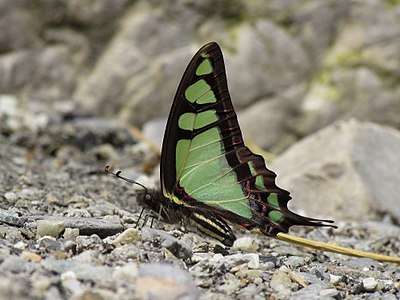Graphium cloanthus
Graphium cloanthus, the glassy bluebottle, is a common, non-threatened tropical butterfly[1] of the family Papilionidae.
| Glassy bluebottle | |
|---|---|
 | |
| Ventral view | |
.jpg) | |
| Dorsal view | |
| Scientific classification | |
| Kingdom: | |
| Phylum: | |
| Class: | |
| Order: | |
| Family: | |
| Genus: | |
| Subgenus: | |
| Species: | G. cloanthus |
| Binomial name | |
| Graphium cloanthus Cramer, 1775 | |
Description
Upperside, forewing: costal margin up to a line through the anterior half of the cell to the apex of the wing and the terminal margin broadly black; the medial portion of the wing pale hyaline (glass like) greenish yellow interrupted anteriorly by the following irregular black bands that join the black on the costa to the black on the termen: a band across middle of cell and along vein 4, another at apex of cell and along vein 5, and two shorter and more oblique nearer the apex of the wing; the hyaline spot left close to the apex much smaller than those below; lastly, a pale subterminal, somewhat obscure broad line. Hindwing: an even black band along the dorsum in continuation of the black on the costal margin of the forewing, joined below to a very broad black band on the terminal margin; the remaining triangular medial portion of the wing and a transverse subterminal series of large spots hyaline greenish-yellow; the dorsal margin of the wing with long soft pale hairs and touches of grey scaling on the tornal area. Underside: similar, with on the hindwing a series of slender crimson markings at extreme base of wing along vein 1, broadened at the tornal angle and in interspaces 2 to 5; lastly, admarginal white slender lines at the tornal angle and in interspaces 2 and 3. Antennae, head, thorax and abdomen dark brownish black, the thorax with lateral dark grey pubescence; beneath: the palpi, thorax and abdomen touched with dingy white, the abdomen with three lateral whitish stripes Male has abdominal fold within grey, studded with a brush of long white hairs as in Graphium sarpedon.[2]
Larva
"Widest at the 5th segment, from which it tapers gradually to the 13th segment. The ridge over the head is furnished with two tubercles, black in front, white posteriorly. The 5th segment has a yellow bar which projects on each side beyond the body and has the appearances of a yoke. The points of the yoke are black. Colour green. The 13th segment is of a pale transparent blue-green. A pale yellow subdorsal line and an almost white spiracular line are the only markings. Head of a greenish-yellow. Legs, claspers and abdomen of the same colour as the 13th segment. The 13th segment ends in two sharp points which join at the end, so that the division between them is visible only on a close examination." (Robson quoted in Bingham 1907)
References
| Wikimedia Commons has media related to Graphium cloanthus. |
| Wikispecies has information related to Graphium cloanthus |
- Collins, N. Mark; Morris, Michael G. (1985). Threatened Swallowtail Butterflies of the World: The IUCN Red Data Book. Gland & Cambridge: IUCN. ISBN 978-2-88032-603-6 – via Biodiversity Heritage Library.
- Bingham, C.T. (1907). The Fauna of British India, Including Ceylon and Burma. II (1st ed.). London: Taylor and Francis, Ltd.